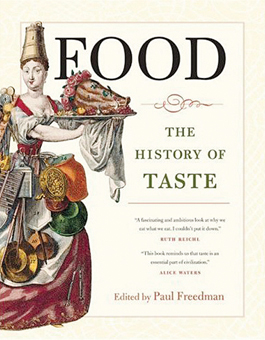home | metro silicon valley index | the arts | books | review

Food: The History Of Taste
Reviewed by Michael S. Gant
Eating begins with a need to nourish but quickly escalates to encompass issues of culture, status and religion—otherwise we would all be content to nosh on the occasional roadkill, and there would be no Michelin stars. In Food: The History of Taste, edited by Paul Freedman, 10 historians survey the course of cuisine, starting with our hunter-gatherer ancestors, sojourning through various regional palates and ending with thoughts on the combination of "Novelty and Tradition" that tugs at diners today. The chapters expand on Freedman's injunction that "taste" be "understood not only as a flavour but the production of an impressive and artistic effect." Alan K. Outram notes that our prehistoric sweet tooth still bedevils modern dieters. Traditional Chinese cuisine, Joanna Waley-Cohen writes, depends upon "the creative combination of different forms of fan and cai," the former to fill (rice and other grains), the latter to flavor or season. In the fascinating chapter on medieval Islam, H.D. Miller notes the importance of cookbooks "because standards of connoisseurship in Baghdad were so high"; even important generals and princes created and codified recipes. In the Middle Ages, national cuisines began to diverge. The English started using wheat starch as a thickening agent, a practice frowned on by the French. The English, also, C.M. Woolgar notes, liked "quirky inspirations," including meatballs dressed up as hedgehogs. By the 1600s, heavily spiced dishes gave way to enhanced intrinsic flavors; the French, naturally, led the way. Mass production and marketing of food changed everyone's diets, especially the lower classes, who had been resigned to food that was "difficult to digest, often poorly prepared [and] inadvertently or deliberately adulterated," as described by Hans J. Teuteberg. Alain Drouard's chapter, "Chefs, Gourmets and Gourmands," serves up a useful history of how the French defined high-end dining for most of the world. The topic of taste is pretty much as open-ended as humanity itself—we are what we eat, after all—so the essays sometimes seem like they are only scratching the surface of an endless repast. The volume is liberally seasoned with illustrations, ranging from cave paintings to vintage menus. Particularly striking is a 1571 Venetian engraving of a three-tiered mechanical roasting spit. Today's backyard chef can only bow in awe. (Edited by Paul Freedman; UC-Press; 368 pages; $39.95 hardback)
Send a letter to the editor about this story.
|
|
|
|
|
|
